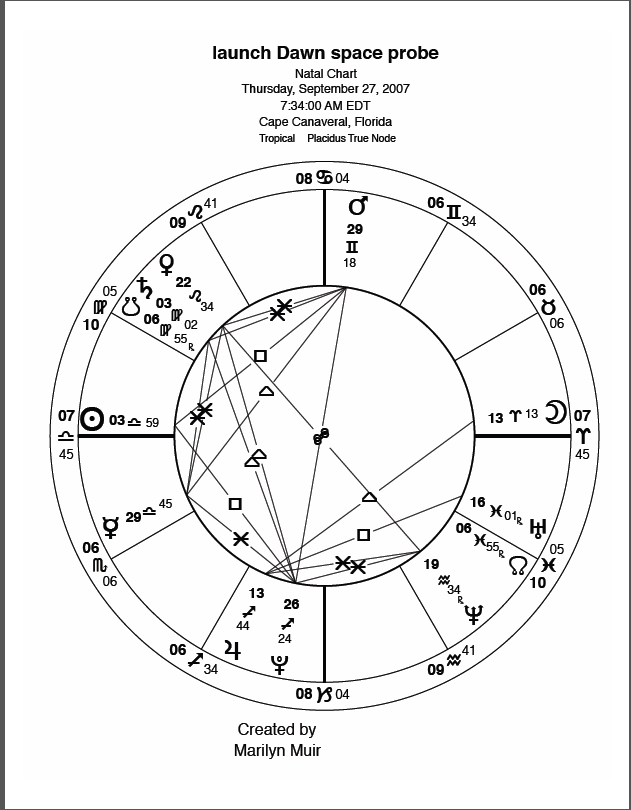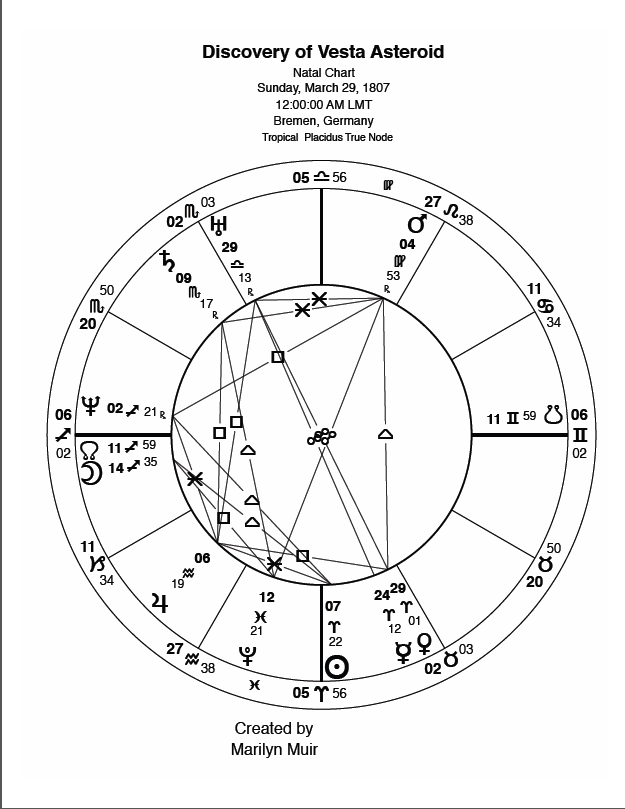by Marilyn J. Muir, LPMAFA

This work is licensed under a Creative Commons Attribution-NonCommercial-ShareAlike 4.0 International License.
There is an astrological statement to which I adhere quite closely: astronomers measure and astrologers interpret. If astronomers tell the story… there is nothing to interpret, facts are facts and they stand alone. Unfortunately, aside from awe at the breadth and scope of the universe and the beauty with which space photography can bless us, there is not much the man on the street can do with the information generated by science. “If there is a body located there and is moving that fast, I will try to avoid hitting it with my spaceship.” Sounds silly doesn’t it?
From an astrological standpoint, we always turn to the science (astronomy) to develop our positions and our chart data. We need the accuracy of such science. Astrologers then ask the question: What does that piece of information mean in mankind’s experience? In other words, astronomy measures (the science) and astrology interprets (the art).
In ancient times astrologers were also astronomers, united in one experience. About 300-400 years ago, the emerging sciences split from their roots as mankind’s intellect blossomed, and as did mankind’s ego. Unfortunately, science threw the baby out with the bathwater and relegated astrology to mankind’s trash heap of superstition and myth. I find it difficult to understand how anyone can value the science of history’s most notable contributors on one hand and condemn the balance of their conclusions as superstition on the other hand. They either were geniuses during their lifetimes or they weren’t. I think they were geniuses for the gifts of knowledge they bestowed upon us. Both fields owe them a debt of gratitude and respect.
As an astrologer, I do my very (untrained) best to keep up with the science because sooner or later it will become an astrologer’s job to interpret it. Currently my attention was drawn to the spaceship that has just taken up residence in an orbit around the asteroid Vesta. What an awesome feat! We launched spaceship Dawn at 11:34:00 UTC (7:34 AM EDT) on September 27, 2007 from Cape Canaveral Air Force Station, Florida. It arrived closest to Mars on February 17, 2009 where it used a Mars-assisted trajectory maneuver to speed it on to its destination, the rendezvous with Vesta. It traveled 1.7 billion miles over a period of almost four years and arrived at Vesta on July 15, 2011 where it was captured by Vesta’s gravity and orbit was established. Dawn will remain in Vesta orbit until 2012. It will then leave that orbit and travel to Ceres to take up a fresh year-long Ceres orbit in 2015. Our engineers and scientists are to be applauded. This was a phenomenal feat. These are the facts, the science. What does all this “mean” to mankind? Enter Astrology.

Let’s do a brief description of asteroids in general and Vesta in particular.
Asteroids are a class of small solar system objects in orbit around our Sun. Science postulates that asteroids are either remnants from the formation of our solar system millions of years ago or perhaps the debris of a destroyed body that occupied the region of the main asteroid belt that exists between Mars and Jupiter. Hundreds of thousands of asteroids in this belt have been identified and thousands more are discovered each year. Ceres and Vesta are the two largest asteroids and are often referred to as planetesimals or proto-planets.
For many years, mankind’s ability to see such small bodies at such large distances kept the asteroid belt invisible to us. The advancement of viewing apparatuses such as the telescope allowed us to see farther and with better definition. In 1801 Ceres was the first asteroid discovered, followed quickly by Pallas, Juno and then Vesta in 1807. That which had been invisible became seen and known. The asteroids were discovered, not invented. That which had been physically present but unconscious in our experience because it was not visible to us, became visible and moved into our waking consciousness.

Our scientists have done their work and it was now time for astrologers to pay attention and develop the body of astrological information. The science is the spaceship and the new information it generates. Astrologers now must interpret. We had the 19th, 20th and now into the 21st Century to do our homework. When we sent out a spaceship in 2007 and placed it into orbit around Vesta we changed the rules of the game. Vesta is not only visible therefore conscious to mankind, but we just made it up close and personal. It is time for us to incorporate Vesta into our culture. Have astrologers done enough homework, developed enough studies or do we need to really get to work and establish better and more solid definitions? The time to pay attention to Vesta in human experience is now!
When spaceship Dawn leaves Vesta in 2012 and races onward to Ceres and its orbit in 2015, we will need to pay similar attention to Ceres in human experience. We have a year to concentrate on Vesta and then it will become Ceres’ turn for study. Are you ready to generate solid research and application through thousands of charts, natal, progressed, directed and transiting? Astrology needs to develop a whole new body of information stemming from the 200+ years of visibility and what we can generate by including Vesta in everything we do. And then we need to share our discoveries with one another.
Astrologically, what does Vesta represent in a chart? Because it is so very easy to access, I Googled both the mythology and the astrology of Vesta. This gave me more than enough resources. Vesta (aka Hestia) was the first-born child of Chronus and Rhea and was equal in stature and power to the more well-known mythological gods. She chose never to marry and to keep herself pure for her task. Generally Vesta is considered the guardian of home and hearth and the keeper of the sacred eternal flame. She watched over both the home and the state. Those who followed in her path were called the Vestal Virgins, priestesses who were free from paternal or masculine control…they belonged to no man and could freely own property. They were revered, respected and honored.
Ancient Assyrian and Babylonian cultures represented Virgo and Scorpio as a single serpent. Later, Libra was inserted between the two, allotting the virgin state to Virgo and the active sexual state to Scorpio with the scales of Libra between. The Latin word for hearth is “focus” according to the Llewellyn definition, which definitely ties easily to Virgo. I did find other definitions but this was the most common theme.
There is no room in this article for sign, house, aspect or definitions. My Google search showed the Bob Marks website with such specific detail. My intention was to turn your attention to the immediate need to develop an understanding and delineation for the Vesta energy at work in the chart. This is a call to arms…there is a whole new body of information that must be developed because we have just gotten up close and personal with a formidable primary goddess and it would be a very good idea to educate ourselves quickly.
P.S.: Don’t lose sight of the upcoming visit to Ceres as well.
Sources:
http://www.nasa.gov/mission_pages/dawn/main/index.html
http://www.space.com/12290-asteroid-vesta-dawn-spacecraft-arrival-preview.html
http://www.google.com/search?hl=en&q=vesta+astrology&revid=-1&sa=X&ei=WII6To-eMM21tgf9wJWJDA&ved=0CGUQ1QIoBA (Vesta + astrology, tons of websites)
http://en.wikipedia.org/wiki/4_Vesta (astronomy)
http://en.wikipedia.org/wiki/Vesta_(mythology)
First published on All Things Healing website Sep 2011, republished with slight editing.

This work is licensed under a Creative Commons Attribution-NonCommercial-ShareAlike 4.0 International License.